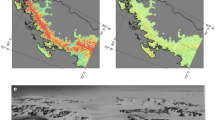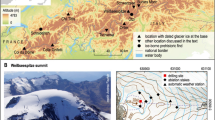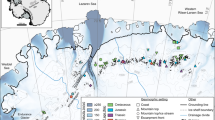Abstract
Extensive valley glaciers have repeatedly covered the inner gorges of the Swiss Alps during Quaternary glaciations. Two controversial explanations of the development of the features have been proposed. In the first, the gorges would have formed anew each time the glaciers receded, through fluvial incision of the previously glaciated surfaces. Alternatively, the valleys could be palimpsest features, carved through successive glacial–interglacial cycles. Here we use topographic data derived from LiDAR measurements to show that fluvial erosion rates of 8.5–18 mm yr−1 would be required to create the current relief of Swiss gorges solely during the present interglacial period. Such high rates exceed the long-term average bedrock erosion rates of even the most tectonically active regions. This scenario would also require that previously incised valleys were erased during successive glaciations by commensurately high glacial erosion rates, a suggestion that is incompatible with available constraints of exhumation from thermochronometry. We therefore suggest that the gorges observed in the Swiss Alps are resilient to repeated glaciations. Our data are most consistent with the hypothesis that gorges are progressively incised below the elevations of glacial trough valleys through multiple glaciations.
This is a preview of subscription content, access via your institution
Access options
Subscribe to this journal
Receive 12 print issues and online access
$259.00 per year
only $21.58 per issue
Buy this article
- Purchase on Springer Link
- Instant access to full article PDF
Prices may be subject to local taxes which are calculated during checkout





Similar content being viewed by others
References
Kelsey, H. M. Formation of inner gorges. Catena 15, 433–458 (1988).
Ouimet, W. B., Whipple, K. X., Crosby, B. T., Johnson, J. P. & Schildgen, T. F. Epigenetic gorges in fluvial landscapes. Earth Surf. Process. Landf. 33, 1993–2009 (2008).
Densmore, A. L. & Hovius, N. Topographic fingerprints of bedrock landslides. Geology 28, 371–374 (2000).
Korup, O. & Schlunegger, F. Bedrock landsliding, river incision, and transience of geomorphic hillslope–channel coupling: Evidence from inner gorges in the Swiss Alps. J. Geophys. Res. 112, F03027 (2007).
Hallet, B., Hunter, L. & Bogen, J. Rates of erosion and sediment evacuation by glaciers: A review of field data and their implications. Glob. Planet. Change 12, 213–235 (1996).
Penck, A. & Brückner, E. Die Alpen im Eiszeitalter (Tauchnitz, 1909).
McEwen, L. J., Matthews, J. A., Shakesby, R. A. & Berrisford, M. S. Holocene gorge excavation linked to boulder fan formation and frost weathering in a Norwegian alpine periglaciofluvial system. Arct. Antarct. Alp. Res. 34, 346–358 (2002).
Brocard, G. Y., van der Beek, P. A., Bourles, D. L., Siame, L. L. & Mugnier, J-L. Long-term fluvial incision rates and postglacial river relaxation time in the French Western Alps from 10Be dating of alluvial terraces with assessment of inheritance, soil development and wind ablation effects. Earth Planet. Sci. Lett. 209, 197–214 (2003).
Schlunegger, F. & Hinderer, M. Pleistocene/Holocene climate change, re-establishment of fluvial drainage network and increase in relief in the Swiss Alps. Terra Nova 15, 88–95 (2003).
Meigs, A., Krugh, W. C., Davis, K. & Bank, G. Ultra-rapid landscape response and sediment yield following glacier retreat, Icy Bay, southern Alaska. Geomorphology 78, 207–221 (2006).
Valla, P. G., van der Beek, P. A. & Carcaillet, J. Dating bedrock gorge incision in the French Western Alps (Ecrins–Pelvoux massif) using cosmogenic 10Be. Terra Nova 22, 18–25 (2009).
Bonney, T. G. Alpine valleys in relation to glaciers. Q. J. Geol. Soc. 58, 690–702 (1902).
Garwood, E. J. Features of Alpine scenery due to glacial protection. Geogr. J. 36, 310–336 (1910).
Cadisch, J. Zur Talgeschichte von Davos. Jahresber. Naturforsch Ges. Graub. 59, 285–299 (1926).
De Graaff, L. W. S. The fluvial factor in the evolution of alpine valleys and of ice-marginal topography in Vorarlberg (W-Austria) during the upper Pleistocene and Holocene. Z. Geomorph. 104, 129–159 (1996).
Kühni, A. & Pfiffner, O. A. The relief of the Swiss Alps and adjacent areas and its relation to lithology and structure: Topographic analysis from a 250-m DEM. Geomorphology 41, 285–307 (2001).
Korup, O. & Schlunegger, F. Rock-type control on erosion-induced uplift, eastern Swiss Alps. Earth Planet. Sci. Lett. 278, 278–285 (2009).
Willett, S. D., Schlunegger, F. & Picotti, V. Messinian climate change and erosional destruction of the central European Alps. Geology 34, 613–616 (2006).
Muttoni, G. et al. Onset of major Pleistocene glaciations in the Alps. Geology 31, 989–992 (2003).
Haeuselmann, P., Granger, D. E., Jeannin, P-Y. & Lauritzen, S-E. Abrupt glacial valley incision at 0.8 Myr dated from cave deposits in Switzerland. Geology 35, 143–146 (2007).
Kahle, H. G. et al. in Results of the National Research Program 20 (NRP 20) (eds Pfiffner, O. A., Lehner, P., Heitzmann, P., Muller, S. & Steck, A.) 251–259 (Birkhäuser, 1997).
Schlatter, A., Schneider, D., Geiger, A. & Kahle, H-G. Recent vertical movements from precise levelling in the vicinity of the city of Basel, Switzerland. Int. J. Earth Sci. 94, 507–514 (2005).
Ivy-Ochs, S. et al. Chronology of the last glacial cycle in the European Alps. J. Quat. Sci. 23, 559–573 (2008).
Jäckli, H. Gegenwartsgeologie des bündnerischen Rheingebietes. Beitr. Geol. Schweiz. Geotech. Ser. 36, 136 (1957).
Lamb, M. P. & Fonstad, M. A. Rapid formation of a modern bedrock canyon by a single flood event. Nature Geosci. 3, 477–481 (2010).
Persaud, M. & Pfiffner, O. A. Active deformation in the eastern Swiss Alps: Post-glacial faults, seismicity and surface uplift. Tectonophysics 385, 59–84 (2004).
Vernon, A. J. et al. Variable late Neogene exhumation of the central European Alps: Low-temperature thermochronology from the Aar Massif, Switzerland, and the Lepontine Dome, Italy. Tectonics 28, TC5004 (2009).
Hinderer, M. Late quaternary denudation of the Alps, valley and lake fillings and modern river loads. Geodin. Acta 14, 231–263 (2001).
Tricart, J. A subglacial gorge: La Gorge du Guil (Hautes-Alpes). J. Glaciol. 3, 646–651 (1960).
Ivy-Ochs, S., Poschinger, A. V., Synal, H-A. & Maisch, M. Surface exposure dating of the Flims landslide, Graubünden, Switzerland. Geomorphology 103, 104–112 (2009).
Acknowledgements
All digital elevation and terrain data reproduced courtesy of swisstopo (JA082265). O.K. acknowledges funding by the German Research Foundation (Heisenberg Programme). D.R.M. thanks the Swiss Federal Research Institute WSL/SLF for hosting a visit that fostered the development of this work.
Author information
Authors and Affiliations
Contributions
O.K. mapped bedrock gorge distributions, conducted terrain analyses, and fieldwork; both authors contributed to conceptualizing, interpreting and writing.
Corresponding authors
Ethics declarations
Competing interests
The authors declare no competing financial interests.
Supplementary information
Supplementary Information
Supplementary Information (PDF 662 kb)
Rights and permissions
About this article
Cite this article
Montgomery, D., Korup, O. Preservation of inner gorges through repeated Alpine glaciations. Nature Geosci 4, 62–67 (2011). https://doi.org/10.1038/ngeo1030
Received:
Accepted:
Published:
Issue Date:
DOI: https://doi.org/10.1038/ngeo1030
This article is cited by
-
Differential erosion and sediment fluxes in the Landquart basin and possible relationships to lithology and tectonic controls
Swiss Journal of Geosciences (2019)
-
Tectonic control on the persistence of glacially sculpted topography
Nature Communications (2015)
-
River gorge eradication by downstream sweep erosion
Nature Geoscience (2014)
-
An ephemeral gorge
Nature Geoscience (2014)
-
Inner gorges cut by subglacial meltwater during Fennoscandian ice sheet decay
Nature Communications (2014)



